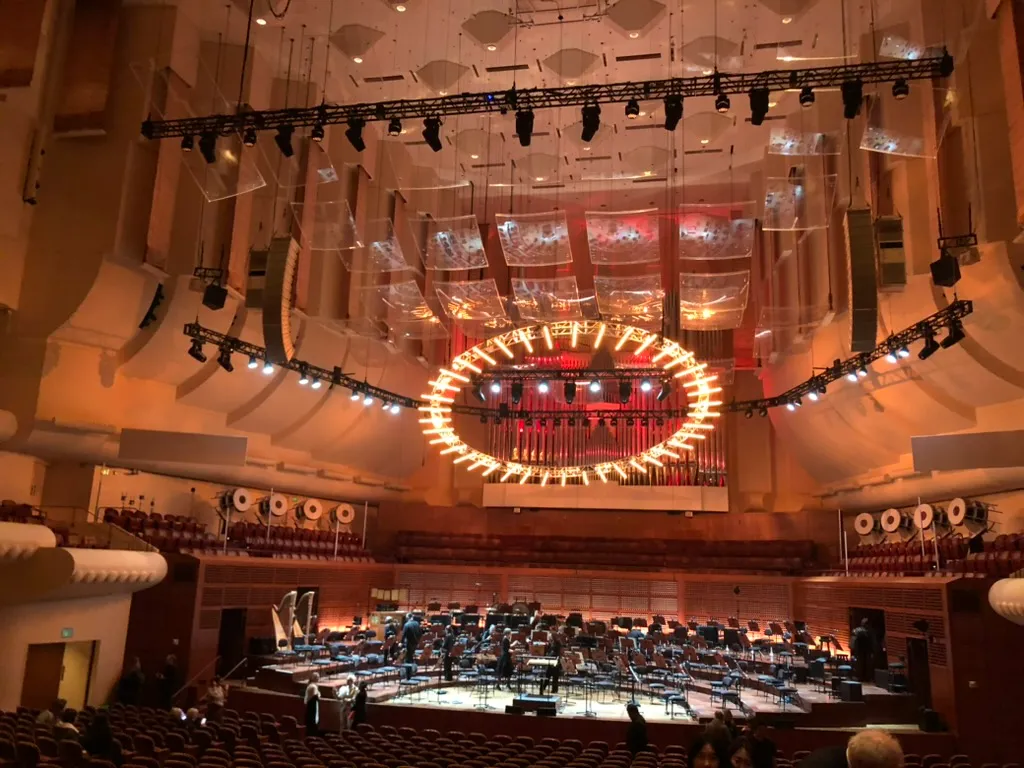Editor’s Note: This article is a review and includes subjective opinions, thoughts and critiques.
Flashing lights! Smoke cannons! And … perfume? While perhaps unusual at a typical symphony concert, lights, smoke and perfume were featured in the San Francisco (SF) Symphony Orchestra’s Saturday performance at Davies Symphony Hall.
Maestro Esa-Pekka Salonen and the orchestra offered their fascinating take on Alexander Scriabin’s tone poem “Prometheus: The Poem of Fire” and Béla Bartók’s opera “Bluebeard’s Castle.”
“Prometheus” by Alexander Scriabin
An abrupt lighting shift from red to pitch black announced the start of “Prometheus.” The orchestra began playing in a fittingly ominous fashion, with terrifyingly dissonant chords and tensely uncertain harmony. The stage was slowly re-illuminated as the piece progressed, with changing colors of light coming from behind the orchestra and a ring of lights overhead.
Red lighting was used to align with dark moments in the music, like sinister growls from the double basses. Red lights enhanced my listening experience.
The frequency of the color in the beginning of the piece signified a warning — perhaps from the gods — in reference to the myth of Prometheus, who brings fire to humans. This was reinforced by the last, ecstatic section of the piece, which saw a brief return of red when the orchestra and choir delivered ominous melodies as a shadow of the warning amid triumph.
A smoke cannon marked the climax in the piece. It felt like a divide between two halves of the piece, where the first half was a warning from the gods while the second half depicted humans experimenting with their new possession of fire.
The piece finished with a resoundingly majestic chord, with its grandeur further magnified as the ring of lights above shone down upon the ensemble in a triumphant kaleidoscope of colors. I’ve never heard an orchestra sound so powerful before, with choir, organ and what sounded like every instrument blasting an F# major chord.
While the usage of red lighting amplified the musicality of the orchestra, lights of other colors introduced confusion to the concert experience.
But I suppose this is less of a criticism for the SF Symphony and more so for Scriabin.
He wrote in colors for the “clavier à lumières,” an instrument he invented for “Prometheus” that projects different colors based on the note being played. The SF Symphony likely orchestrated their color lighting based on Scriabin’s composition, but these lights distracted me from the music instead of clarifying its meaning.
Other distractions included perfume, with scents emitted over the audience at moments in “Prometheus.”
The most prominent one was a rather woody scent, one that reminded me of furniture. I couldn’t really identify it or understand its contribution to the overall performance, though it was a thought-provoking addition.
“Bluebeard’s Castle” by Béla Bartók
The one-act opera is based on a French folk legend that features the mysterious and sinister duke Bluebeard and his new wife Judith and revolves around Judith opening seven locked doors in Bluebeard’s castle.
Each door reveals “symbols of different aspects of Bluebeard’s mind,” as described in the concert’s program notes. Judith grows increasingly horrified as she discovers what the first five doors concealed.
The orchestra took audience members on an emotional roller coaster as Judith finds a torture chamber at the first door and an armory at the second, both covered in blood. Behind the following three doors, Judith is met with a stash of blood-stained jewels and crowns, a garden growing out of pools of blood and a view of Bluebeard’s kingdom with blood-red clouds looming overhead.
I found “Bluebeard’s Castle” to be an incredible operatic work, performed with phenomenal control and character. Maestro Esa-Pekka Salonen, the orchestra and singers bass-baritone Gerald Finley (Bluebeard) and mezzo-soprano Michelle DeYoung (Judith) masterfully depicted Judith’s reaction to opening each door, from the horror of the torture chamber to the grandeur of the kingdom.
The opening of the fifth door was one of the most impactful moments in the entire concert. With the orchestra building up to a staggering volume, Bartók set up great anticipation for a huge explosion of sound to open the fifth door.
And explode, Salonen did.
At the opening of the fifth door, Salonen whipped around to signal to the organist, who was seated behind the audience. As the emphatic chord was struck, every single light turned on to flood the audience with white light. Listeners were transported to a completely new and bright setting that reflected the majesty of Bluebeard’s kingdom, accompanied by blasts of orchestral chords.
My favorite musical door depiction was the sixth, which revealed a serene white lake being described by Judith, which Bluebeard insists was filled with his tears. The harp and flute motif that punctured the serene strings was so beautiful, yet it carried a foreboding feeling that set up Judith’s tirade in anticipation of what was behind the seventh door — where the truth about why Bluebeard brought Judith to his castle was revealed.
It it difficult for me to criticize “Bluebeard’s Castle.” The maestro, orchestra and incredibly talented singers delivered a phenomenal performance.
The lighting was also used far more effectively than in “Prometheus,” from the makeshift sun illuminating the castle chamber to the “clouds” above the white lake wonderfully painting the setting changes.
